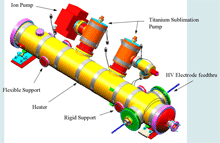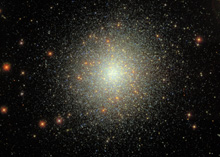 | Wednesday, November 23, 2005 |
|
Wednesday, November 23 - There will be no ILC R&D Meeting or Fermilab Colloquium this week. - There will be no Director's Coffee Break Today. Thursday, Novermber 24 Happy Thanksgiving! |
|
Extended Forecast |
Secon Level 3 |
|
Wednesday, November 23 - Italian Wedding with Meatballs - Diner Style Patty Melt - Chicken a la Mer - Beef and Broccoli - Greek Chicken Panini with Feta Cheese - Sicilian Style Pizza The Wilson Hall Cafe accepts Visa, Master Card, Discover and American Express at Cash Register #1. |
|
Wednesday, November 23
Thursday, November 24
Chez Leon Menu |
| Fermilab Today is online at: http://www.fnal.gov/today/ Send comments and suggestions to today@fnal.gov Fermilab Today archive Hurricane Relief Page Fermilab Today PDF Version Fermilab Result of the Week archive Fermilab Safety Tip of the Week archive Linear Collider News archive Fermilab Today classifieds Subscribe/Unsubscribe to |
| Tevatron Temporarily Down |
On Monday afternoon, a quench in the Tevatron resulted in a damaged cold
box, an interface of the cryogenic system with the superconducting magnets.
To replace the cold box, technicians need to warm up a section of the
Tevatron, install a new cold box, carry out a leak check and then cool down
the Tevatron. If the repairs proceed as expected and if no other damage is
found, accelerator experts will be able to turn the Tevatron back on in
about ten days. —Kurt Riesselmann |
| Crash Course in Luminosity, Key to Discovery at Fermilab | ||
| This is the sixth story in a series that explains what luminosity is, and why we've recently gotten better at producing it at the Tevatron. | ||
|
Collisions in the Right Place Usually, when we think of luminosity, we think of increasing collisions. But it's Ron Moore's job to prevent collisions in the Tevatron--at least until the particle bunches reach the detectors and head-on collisions have been initiated at CDF and DZero. Now, with rising pbar numbers , Moore, the head of the Tevatron department, has a big job on his hands. "The recycler and the pbar source have recently delivered record pbar intensities to the Tevatron," said Moore. "They're really pushing the envelope, so now we have to deal with that." Moore and his colleagues worry about how to make the most of the protons and antiprotons that are injected into the Tevatron. Among other things, that means preventing premature collisions that waste antiprotons and reduce luminosity at the detectors. "The hard part is that we have 36 bunches of protons and 36 bunches of antiprotons orbiting inside the same pipe," said Yuri Alexahin, a physicist in the Accelerator Physics department. "It is very difficult to separate them enough to avoid unwanted collisions." As the 36 bunches of protons and antiprotons circle the Tevatron in opposite directions, they snake around each other. "We call it the helix," said Moore. "If we didn't steer the bunches in separate orbits, each proton and pbar bunch would see 72 head-on collisions per revolution rather than just two." With a total of 138 possible collision points and over a trillion particles per bunch, there are plenty of opportunities for beam-beam interference. For this reason, the helical orbits are essential for preventing parasitic collisions.
The helical orbits are achieved using stainless steel electrostatic separators, which create an electric field that pulls the protons in one direction and the antiprotons in the other direction. Electrostatic separators have been in operation since Run II started, but they have been adjusted and improved over the last few years. In 2001, when Run II began, parasitic collisions claimed 30 to 35 percent of the antiprotons in the beams. But in the last couple of years, thanks largely to installation of additional separators and fine-tuning by Alexahin, the number of antiprotons lost to parasitic collisions has fallen to less than 3 percent. Now that there are more particles in each beam, Alexahin, Moore and the whole division will face new challenges.
|
| CMS Celebrates Milestone |
Last Friday at lunchtime, the CMS department got together over cake to celebrate the 97 percent completion milestone, also known as the CD4A. CD4A marks a turing point in America's contribution to CMS, ATLAS and the LHC. American physicists reached this milestone on time in Sepetember, and were officially recognized by the DOE for 97 percent completion earlier this month. Since the milestone was reached, Fermilab physicists have been gathering data from the completed pieces as a trial run for CERN's Compact Muon Solenoid project kick-off in 2007. "Now it's time to think about how we are going to get the physics out of this," said Dan Green, the US CMS spokesperson. "We don't look back too much."
—Siri Steiner |
|
From SciDevNet, November 22, 2005: Argentinean hunt for cosmic rays brings local benefits [MALARGÜE] The world's largest 'cosmic ray' observatory, which opened officially this month in Argentina, is already bringing social and economic benefits to local communities. The Pierre Auger Observatory is the result of a 15-nation collaboration whose facilities are spread across a vast area of Argentina.
Conceived in 1992 by James Cronin, winner of the 1980 Nobel Prize for physics, and Alan Watson of the University of Leeds, United States, the observatory will study cosmic rays — the Universe's highest-energy particles.
|
|
Brinson Fellowship Offers Opportunity
With New Particle Astrophysics Center | |
| |
|
The new Fermilab Particle Astrophysics Center is inviting applications
for the second Brinson Predoctoral Fellowship, intended for Ph.D. students
in their last year of study. The recipient would spend the final year of
graduate study in residence at Fermilab working with members of the Particle
Astrophysics Center -- including scientists in Theoretical Astrophysics and Cosmology,
the Sloan Digital Sky Survey, the Pierre Auger Project, the Cryogenic Dark Matter
Search, the Dark Energy Survey, and SNAP/JDEM.
The fellowship will provide $2,000 per month salary as well as $1,000 toward travel expenses. The student's institution would be responsible for health insurance, as well as any tuition and fees. Cosmologist Rocky Kolb, the Director of the Center, noted that, while Fermilab is not specifically an educational institution, the opportunity to train "the stars of the future" in particle astrophysics is invaluable. "Particle cosmology is a reasonably new field," he said. "Establishing this world-class center means we can attract future leaders with the chance to further their career and their education, and to have an impact on the field for many years to come. We will advertise worldwide, with the goal of attracting the best graduate students." The fellowship is funded by The Brinson Foundation of Chicago, whose interests in scientific research include astrophysics and cosmology as well as geophysics and medical research. The Brinson Foundation lists Chicago's Adler Planetarium among its many annual grants.
The deadline for receiving applications is Dec. 31, 2005. For further information, contact David Finley, Chair of the Selection Committee,
at finley@fnal.gov, x4620, or Rocky Kolb
at rocky@fnal.gov, x4695. Additional
information may be found online.
|
| FBI Warns of E-Mail About Surveillance |
WASHINGTON (AP) - The Federal Bureau of Investigation issued an alert
Monday about a scam involving unsolicited e-mails, purportedly sent by
the FBI, that tell computer users that their Internet surfing is being
monitored by the agency.
The users are told they have visited illegal Web sites and are instructed to open an attachment to answer questions. The FBI did not send these e-mails and does not send any other unsolicited e-mails to the public, an agency statement said. As many harmful computer viruses are located in e-mail attachments, the FBI said it strongly encourages computer users not to open attachments from unknown recipients. The FBI is investigating the scam. Recipients of these e-mails are asked to report them by visiting the Internet Crime Complaint Center. |
|
Inclement Weather Snow Removal While Wilson Hall has a snow melt system for the front center plaza, portions of the front sidewalk, and stairs to the east and west parking lots, the snow melt system does not cover all front areas of the plaza or all sidewalks. For this reason, residents will see barricades and ropes to section off the areas not on the snow melt system. During periods of heavy snow and sub zero temperatures beyond the design criteria of the snow melt system, additional barricades will be placed in the front plaza area until snow removal crews can respond. As in previous winters, sections of North Eola Road and West Wilson Road may be closed during extreme winter conditions.
Give the Gift of Good Health
Entertainment Books are On Sale
|

